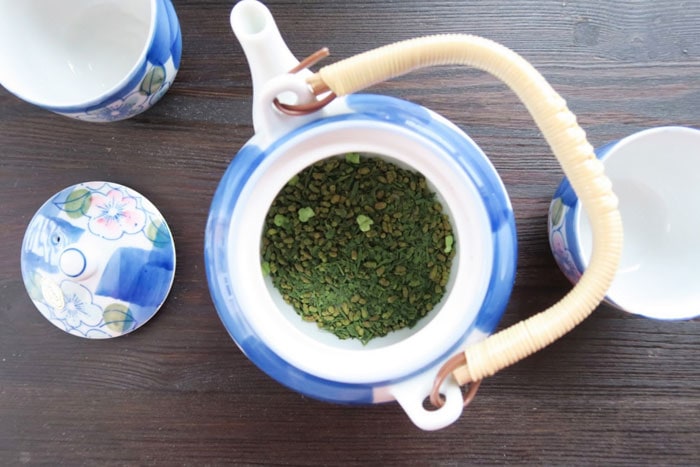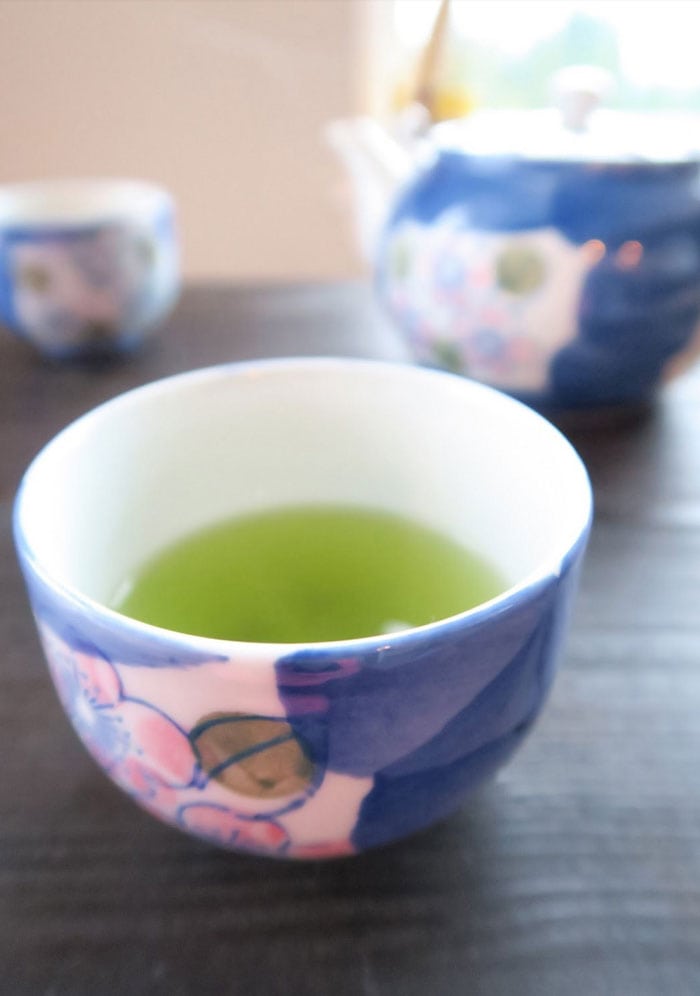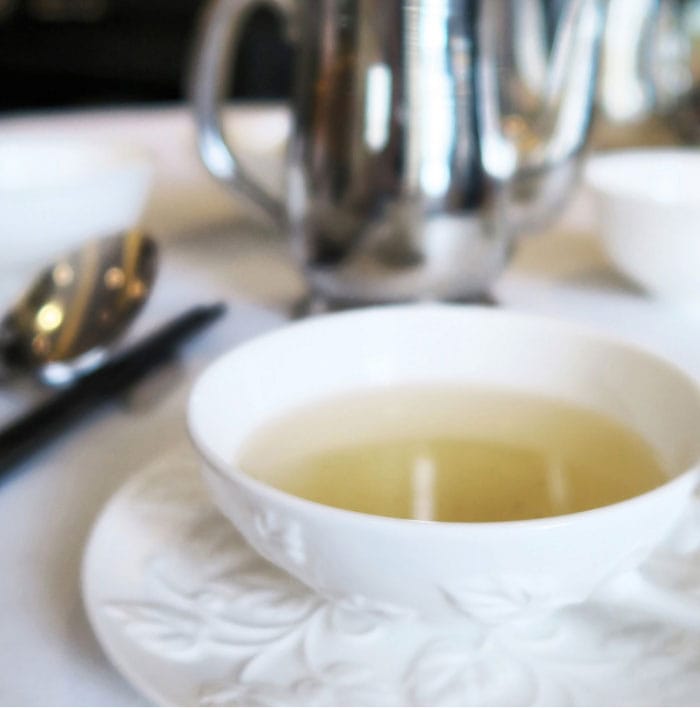
Written By: Gloria Tsang, RD
Title: Founding Registered Dietitian
Alumni: University of British Columbia
Last Updated on:

Tea is the most commonly consumed beverage in the world, second only after water. Among all varieties of tea – black, green, white, oolong, red, herbal – which one offer the most health benefits? Should you avoid adding milk in your tea? Does decaf tea provides the same health benefits?

Table of Contents
Black, green, white, and oolong teas derive their leaves from a warm-weather evergreen tree known as Camellia sinensis. The leaves from this tree contain antioxidant polyphenols. As a general rule of thumb, the more oxidizing processing tea leaves undergo, the darker they will turn.
White tea is derived from the young new leaves from the Camellia plant in early spring. These young leaves contain little or no chlorophyll, therefore they are silvery white. White tea is the least processed tea, almost unoxidized.
Green tea is the most studied tea for investigating health benefits. The most prominent benefits are derived from its high antioxidant content, particularly catechins, with anti-cancer properties. Studies found that a cup of green tea contains about 105 mg of catechins, whereas a cup of black tea only provides 10 mg. Chinese green teas are usually wok-roasted, unlike the Japanese steaming process. Both processes actually halts the natural enzymes, preventing them from oxidizing tea’s natural polyphenols. Among all green tea, matcha contains the highest level of catechin epigallocatechin gallate (EGCG), indeed 137 times more than regular green tea! Amazingly, EGCG has been shown to speed up your body’s metabolism, which may help to keep the weight off.

Western countries call their tea “black tea”, while the Asian countries called it “red tea”. That’s because we name it by the color of the black tea leaves, while the Chinese and Japanese name it for the color of the red liquid. Regardless of how we call it, black tea possesses different antioxidants as a result of an additional oxidation process. Such process decreases catechin content, but produces other unique antioxidants, namely theaflavins and thearubigins. It is indeed theaflavins that is responsible for the unique red brewed color! Studies found that these two compounds are capable of lowering cholesterol.
Oolong tea is semi-oxidized, falls right in-between green and black tea in terms of processing. Therefore it contains antioxidant profiles of both teas, that is catechins from green tea and theaflavins and thearubigins from black tea.
Pu-er (sometimes spell Pu-erh) is the only tea that has undergone fermentation, similar to that of how wine and yogurt are made. Bacterial and yeast fermentation is introduced in the processing. Such fermentation produces a unique antioxidant called theabrownin. Animal studies have found that theabrownin possesses cholesterol-lowering properties.
Herbal tea is not derived from the leaves of the Camellia plant and so does not have the particular health-promoting properties mentioned above. Indeed, most herbal teas in the market technically are not tea. They are only infusions made with herbs, flowers, roots, spices or other parts of some plants. The proper term for this type of beverage is “tisane.”
The recently popular hibiscus tea and South African red Rooibos tea also fall within the herbal tea or tisane category. Although red Rooibos tea doesn’t come from the Camillia plant, recent studies showed that Rooibos tea contains quercetin, an antioxidant that has been found to benefit heart health, and can act as an anti-inflammatory agent, protecting bodies from other chronic inflammatory diseases.
Although herbal tea has not been proven for heart health and cancer prevention, it is still a plant-based drink and is better than soda and juice! Most plants contain some levels of antioxidants, as it is a natural mechanism to protect themselves against extended sun exposure.
Yes, indeed. And it’s not because of calories. A small 2007 European study found that the addition of milk into black tea completely blunted its heart health beneficial effects! So, try drinking tea plain!

A cup of tea contains about 30 to 100 mg of caffeine. This amount is low compared to about 120 mg of caffeine present in a cup of home-brewed coffee. A few studies found that decaf tea contains less flavonol than regular tea. The lower ORAC values from decaf tea also support the findings of less flavonol content. A 2003 UCLA study found that the ORAC values of decaf tea ranged from 507 to 845 trolox equivalents per gram. Regular tea, on the other hand, was measured to have ORAC values of 728 to 1686. We suspect that the process of removing caffeine may have removed some beneficial flavonol antioxidants. Based on the above findings, we recommend sticking to regular tea!
In addition, all tea contains L-Theanine, a unique compound that give a sense of relaxation. That’s why buddhist monks use tea to help them meditate. And that’s also probably why despite the caffeine content, tea drinkers never complain about being agitated, or unable to fall asleep!
The Tea Association of the USA approximates that 85% of tea consumed in America is iced. Unfortunately, iced tea doesn’t necessary provide the same health benefits as brewed tea. A report by the American Chemical Society found that bottled iced tea contain fewer polyphenols than brewed green or black tea. And don’t forget about the calories content too; brewed tea contains zero calories while a cup of bottled iced tea contains an average of 86 calories.
Different tea offers health benefits. So try drinking a variety, not just one specific kind. Brew your tea for at least 3 – 5 minutes to bring out the beneficial polyphenols. Don’t forget to enjoy the wonderful aromas of all tea!
Alumni: University of British Columbia – Gloria Tsang is the author of 6 books and the founder of HealthCastle.com, the largest online nutrition network run by registered dietitians. Her work has appeared in major national publications, and she is a regularly featured nutrition expert for media outlets across the country. The Huffington Post named her one of its Top 20 Nutrition Experts on Twitter. Gloria’s articles have appeared on various media such as Reuters, NBC & ABC affiliates, The Chicago Sun-Times, Reader’s Digest Canada, iVillage and USA Today.
anti-inflammatory, antioxidant, black tea, caffeine, ceylon, decaf, earl grey, green tea, herbal tea, hibiscus tea, iced tea, kung fu tea, matcha, oolong, pu-er, rooibos, sencha, shou mei, tea, white tea